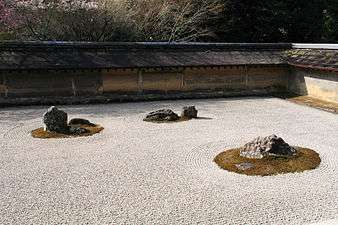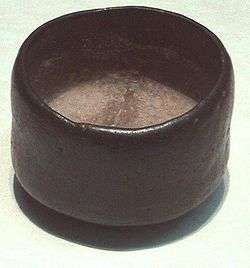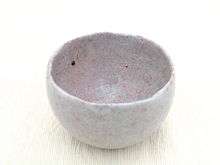Wabi-sabi



Wabi-sabi (侘寂) represents Japanese aesthetics and a Japanese world view centered on the acceptance of transience and imperfection. The aesthetic is sometimes described as one of beauty that is "imperfect, impermanent, and incomplete".[2] It is a concept derived from the Buddhist teaching of the three marks of existence (三法印 sanbōin), specifically impermanence (無常 mujō), suffering (苦 ku) and emptiness or absence of self-nature (空 kū).
Characteristics of the wabi-sabi aesthetic include asymmetry, roughness, simplicity, economy, austerity, modesty, intimacy, and appreciation of the ingenuous integrity of natural objects and processes.
Description
According to Leonard Koren, wabi-sabi can be defined as "the most conspicuous and characteristic feature of traditional Japanese beauty and it occupies roughly the same position in the Japanese pantheon of aesthetic values as do the Greek ideals of beauty and perfection in the West."[2] Whereas Andrew Juniper notes that "[i]f an object or expression can bring about, within us, a sense of serene melancholy and a spiritual longing, then that object could be said to be wabi-sabi."[3] For Richard Powell, "[w]abi-sabi nurtures all that is authentic by acknowledging three simple realities: nothing lasts, nothing is finished, and nothing is perfect."[4] Buddhist author Taro Gold describes wabi-sabi as "the wisdom and beauty of imperfection."[5]
The words wabi and sabi do not translate easily. Wabi originally referred to the loneliness of living in nature, remote from society; sabi meant "chill", "lean" or "withered". Around the 14th century these meanings began to change, taking on more positive connotations.[2] Wabi now connotes rustic simplicity, freshness or quietness, and can be applied to both natural and human-made objects, or understated elegance. It can also refer to quirks and anomalies arising from the process of construction, which add uniqueness and elegance to the object. Sabi is beauty or serenity that comes with age, when the life of the object and its impermanence are evidenced in its patina and wear, or in any visible repairs.
After centuries of incorporating artistic and Buddhist influences from China, wabi-sabi eventually evolved into a distinctly Japanese ideal. Over time, the meanings of wabi and sabi shifted to become more lighthearted and hopeful. Around 700 years ago, particularly among the Japanese nobility, understanding emptiness and imperfection was honored as tantamount to the first step to satori, or enlightenment. In today's Japan, the meaning of wabi-sabi is often condensed to "wisdom in natural simplicity." In art books, it is typically defined as "flawed beauty."[6]
From an engineering or design point of view, wabi may be interpreted as the imperfect quality of any object, due to inevitable limitations in design and construction/manufacture especially with respect to unpredictable or changing usage conditions; then sabi could be interpreted as the aspect of imperfect reliability, or limited mortality of any object, hence the phonological and etymological connection with the Japanese word sabi, to rust. Specifically, although the Japanese kanji characters 錆 (sabi, meaning "rust") and 寂 (sabi, as above) are different, as are their applied meanings, the original spoken word (pre-kanji, yamato-kotoba) is believed to be one and the same.[7][8]

A good example of this embodiment may be seen in certain styles of Japanese pottery. In the Japanese tea ceremony, the pottery items used are often rustic and simple-looking, e.g. Hagi ware, with shapes that are not quite symmetrical, and colors or textures that appear to emphasize an unrefined or simple style. In fact, it is up to the knowledge and observational ability of the participant to notice and discern the hidden signs of a truly excellent design or glaze (akin to the appearance of a diamond in the rough). This may be interpreted as a kind of wabi-sabi aesthetic, further confirmed by the way the colour of glazed items is known to change over time as hot water is repeatedly poured into them (sabi) and the fact that tea bowls are often deliberately chipped or nicked at the bottom (wabi), which serves as a kind of signature of the Hagi-yaki style.
Wabi and sabi both suggest sentiments of desolation and solitude. In the Mahayana Buddhist view of the universe, these may be viewed as positive characteristics, representing liberation from a material world and transcendence to a simpler life. Mahayana philosophy itself, however, warns that genuine understanding cannot be achieved through words or language, so accepting wabi-sabi on nonverbal terms may be the most appropriate approach. Simon Brown[9] notes that wabi-sabi describes a means whereby students can learn to live life through the senses and better engage in life as it happens, rather than be caught up in unnecessary thoughts. In this sense wabi-sabi is the material representation of Zen Buddhism. The idea is that being surrounded by natural, changing, unique objects helps us connect to our real world and escape potentially stressful distractions.
In one sense wabi-sabi is a training whereby the student of wabi-sabi learns to find the most basic, natural objects interesting, fascinating and beautiful. Fading autumn leaves would be an example. Wabi-sabi can change our perception of the world to the extent that a chip or crack in a vase makes it more interesting and gives the object greater meditative value. Similarly materials that age such as bare wood, paper and fabric become more interesting as they exhibit changes that can be observed over time.
The wabi and sabi concepts are religious in origin, but actual usage of the words in Japanese is often quite casual. The syncretic nature of Japanese belief systems should be noted.
Wabi-sabi in Japanese arts
Many Japanese arts over the past thousand years have been influenced by Zen and Mahayana philosophy, particularly acceptance and contemplation of the imperfection, constant flux and impermanence of all things. Such arts can exemplify a wabi-sabi aesthetic. Examples include:
- Honkyoku (traditional shakuhachi music of wandering Zen monks)
- Ikebana (flower arrangement)
- Japanese gardens, Zen gardens and bonsai (tray gardens)
- Japanese poetry
- Japanese pottery, Hagi ware, Raku ware
- Japanese tea ceremony
A contemporary Japanese appraisal of this concept is found in the influential essay In Praise of Shadows by Jun'ichirō Tanizaki.
Western use
Designer Leonard Koren (b. 1948) in 1994 published Wabi-Sabi for Artists, Designers, Poets & Philosophers[2] as an examination of wabi-sabi, contrasting it with Western ideals of beauty. According to Penelope Green, Koren's book subsequently "became a talking point for a wasteful culture intent on penitence and a touchstone for designers of all stripes."[10]
Potter Bernard Leach (1887–1979) was deeply influenced by Japanese aesthetics and techniques and founded an influential European aesthetic movement which also included Dame Lucy Rie and Hans Coper.
Some haiku in English adapt the wabi-sabi aesthetic, with spare, minimalist poems that evoke loneliness and transience, such as Nick Virgilio's "autumn twilight:/ the wreath on the door/ lifts in the wind".[11]
The work of American artist John Connell (born 1940) is centered on the idea of wabi.[12]
During the 1990s the concept was borrowed by computer software developers and employed in Agile programming and Wiki to describe acceptance of the state of ongoing imperfection that is the product of these methods.[13]
On 16 March 2009, Marcel Theroux presented "In Search of Wabi Sabi" on BBC Four as part of the channel's Hidden Japan season of programming. Theroux traveled throughout Japan trying to understand the aesthetic tastes of its people, beginning by comically enacting a challenge from the book Living Wabi Sabi by Taro Gold to "ask people on a Tokyo street to describe Wabi Sabi." Theroux showed that, just as Gold predicted, "they will likely give you a polite shrug and explain that Wabi Sabi is simply unexplainable."[14]
Wabi Sabi was referenced in a King of the Hill episode where Bobby Hill entered a rose growing competition. His sponsors were a smoke shop and showed Bobby that the imperfection of the rose made the rose better.
Jack Dorsey, the billionaire founder of Twitter and Square, promotes the Wabi-sabi philosophy of design.[15]
See also
- Clinamen
- Higashiyama Bunka in Muromachi period
- Iki (a Japanese aesthetic ideal)
- Mono no aware
- Shibui
- Teaism
- Wabi-cha
- Kintsugi (also known as Kintsukuroi)
- Distressing
References
- ↑ 森神逍遥 『侘び然び幽玄のこころ』桜の花出版、2015年 Morigami Shouyo,"Wabi sabi yugen no kokoro : seiyo tetsugaku o koeru joi ishiki" (Japanese) ISBN 978-4434201424
- 1 2 3 4 Koren, Leonard (1994). Wabi-Sabi for Artists, Designers, Poets and Philosophers. Stone Bridge Press. ISBN 1-880656-12-4.
- ↑ Juniper, Andrew (2003). Wabi Sabi: The Japanese Art of Impermanence. Tuttle Publishing. ISBN 0-8048-3482-2.
- ↑ Powell, Richard R. (2004). Wabi Sabi Simple. Adams Media. ISBN 1-59337-178-0.
- ↑ Gold, Taro (2004). Living Wabi Sabi. Andrews McMeel Publishing. ISBN 0-7407-3960-3.
- ↑ Gold (2004), pp. 20–21.
- ↑ 錆びをめぐる話題,井上勝也,裳華房, 1994
- ↑ さびの文字 on the Kinugawa Chain Mfg. Co. Ltd website
- ↑ Brown, Simon (2007). Practical Wabi Sabi. Carroll & Brown. ISBN 1-904760-55-4.
- ↑ Green, Penelope. "An Idiosyncratic Designer, a Serene New Home". New York Times. Retrieved 25 September 2012.
- ↑ Cor van den Heuvel, editor. The Haiku Anthology. Fireside, 1986. ISBN 0671628372 p285
- ↑ Hess Art Collection, Hatje Cantz, 2010
- ↑ "Wabi Sabi". Retrieved 2006-11-19.
- ↑ Gold (2004), p. 6.
- ↑ Levy, Steven (June 22, 2012). "The Many Sides of Jack Dorsey". Wired. Retrieved 2013-05-24.
Bibliography
- Crowley, James and Sandra (2001). Wabi Sabi Style. Gibbs Smith, Publisher. ISBN 1-58685-753-3.
- Suzuki, Daisetz T. (1959). "Chapter 2: General Remarks on Japanese Art Culture". Zen and Japanese Culture. New York: MJF Books. pp. 19–38. ISBN 1-56731-124-5.
- Tierney, Lennox (1999), Wabi Sabi, Layton, Utah: Gibbs Smith, Publisher. ISBN 0-87905-849-8